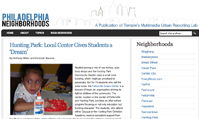Many of the New Voices sites are university affiliated and show great promise for covering community news, but these efforts can also be steeped in great peril. They must run year-round if they are going to maintain momentum and credibility as a reliable news source.
The best university models are those in which community coverage is integrated into the journalism curriculum so that students are learning how to do journalism in the community, and the university is developing listening posts. Temple University, for instance, requires its students to work in its Multimedia Urban Reporting Lab (MURL), which produces Philadelphia Neighborhoods. Columbia College Chicago students provide rich content to Chicago Talks.
Other USC-Annenberg faculty members have approached Willa Seidenberg to offer student content for her Intersections: South L.A. site. For one class covering the Inglewood community, she promised to post every publishable story. Not only was every student published, the teacher also said it was “the best class she ever taught.”

The best university models are those in which community coverage is integrated into the journalism curriculum.
“Students liked being published on a real working site, receiving comments, meeting people who had read their work,” she said. “As a reporting lab, these students got the very best experience in journalism. And, in return, the community got a lot of coverage it would not ordinarily receive.”
Grand Avenue News’ Grinfeder, however, found so many University of Miami journalism students interviewing the same people in Coconut Grove that he assigned students to specific areas to avoid overlap.
Other university projects have paid student interns, hired grad students as editors, or parachuted journalism students into the community as trainers.
And one project, PolicyOptions.org, involved university experts working with students to create white papers on public issues. Twenty campuses have researched 150 issues papers, which are starting to be posted online.
Early in the program, J-Lab required, as a condition of receiving a New Voices grant, that a university commit to operating its news site year round. We learned that it was impossible to maintain the momentum of a startup community news site if it went dark over Christmas, spring break and the summer.
We strongly recommend, however, that university projects figure out in advance what hurdles they will have to leap before launching a community news site. Several of the New Voices projects have been seriously hamstrung by university requirements that deprived them of the nimbleness they needed.
Several of the New Voices projects have been seriously hamstrung by university requirements that deprived them of the nimbleness they needed.
Some were caught in university competitive bidding requirements that delayed hiring or prevented them from using web developers and vendors from their target community. Some were blocked from using grant money to pay community contributors. Others found that if they used New Voices funds to pay student writers, the university deducted those payments from the students’ scholarship awards. One project was prevented from locating grant-funded equipment in micro bureaus in their targeted community. Universities also have resisted putting “Donation” buttons on the New Voices websites. And several projects experienced considerable delays from incompatibility and poor service issues with university tech departments.
Still, there are growing opportunities. USC’s Marshall School of Business consulting program, for example, has accepted Intersections: South L.A. as a client to develop a marketing plan.
And Kent State’s aviation storytelling site, Stories That Fly, has far-reaching research plans if it nails the $10,000 it needs to match a $40,000 pledge to acquire a Piper Club as part of its equipment needs. If it is successful, said founder Joe Murray, two biologist colleagues have expressed interest in working with STF on a currently funded water conservation project and other environmental research projects are in the offing.
We also learned that distance is fatal. Some schools sought to ramp up news sites for communities that were hours away from campus. West Virginia University and the Universities of Montana and Nevada-Reno launched projects that involved lengthy round trip travel that could not be sustained after the grant. Of U-Montana’s two sites, the Dutton Country Courier has been handed off to a local newspaper; the stunning CrowNews.net has had no takers yet. West Virginia’s community radio project and Reno’s Nuestro Tahoe lapsed after their grants.
To realize the full potential for connecting with their communities via news sites, universities need to create entrepreneurial centers for community outreach and engagement that can circumnavigate disabling red tape.
